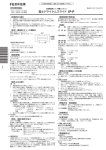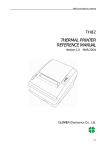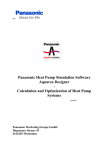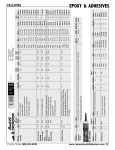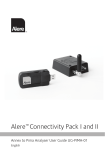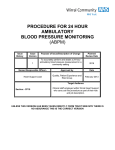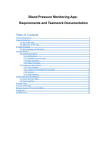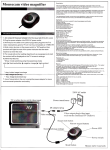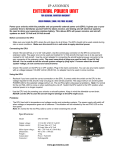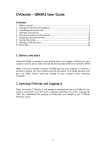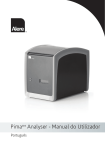Download NHS Camden Health Checks GP Handbook
Transcript
NHS Health Check Handbook for General Practice May 2014 2 NHS HEALTH CHECK Handbook for General Practice Foreword May 2014 Dear Colleague, NHS Health Checks in Camden Welcome to the Camden NHS Health Checks Handbook for General Practice. This handbook is designed to support general practice teams in Camden to: Identify their populations eligible for a NHS Health Check; Invite patients for a check; Complete the health check in accordance with LCS specification; and Ensure patients are offered lifestyle support by the local Health Check Follow Up service. As a consequence of the Health and Social Care Act 2012, responsibility for many public health functions has transferred to local government, including responsibility for commissioning NHS Health Checks. Despite this change in the commissioning landscape, general practice continues to play a vital role in the successful delivery of the Health Checks programme in Camden. We recognise that general practice is best placed to proactively invite patients and opportunistically offer checks as part of routine clinical care; conduct high quality checks; assess and communicate cardiovascular risk to patients; and help patients to manage their CVD or any vascular disease identified as a result of the check. Working with colleagues from both Camden CCG and the Local Medical Committee, we have taken the opportunity to review and re-launch GP delivery of NHS Health Checks. Through this re-launch of the programme in general practice, we hope to: Engage all GP practices in the delivery of NHS Health Checks in Camden, thereby increasing the accessibility and uptake of health checks amongst Camden patients. Ensure that high-risk groups are prioritised for Health Checks in primary care, in order to tackle inequalities in cardiovascular health within the borough. Support early identification of CVD, kidney disease and diabetes Reduction of health inequalities is a key strategic priority for Camden Council, as set out in the Camden Plan. Cardiovascular disease (CVD) is the biggest killer in Camden and the single largest cause of health inequalities. CVD differentially affects black and minority ethnic groups and socially disadvantaged populations. By incentivising practices to target those patients who are most likely to be at high risk of CVD (based NHS HEALTH CHECK Handbook for General Practice 3 on a range of risk factors), as well as those on Mental Health and Learning Disability registers, we hope to harness the potential of the NHS health checks programme to impact significantly on health inequalities. I want to thank you for your past commitment to and hard work in delivering Health Checks in Camden, and sincerely hope that you will continue to support the programme in 2014/15 and beyond. The Camden and Islington Public Health team is equally committed to working with and supporting general practice to help make this programme a success, and we always welcome any feedback on how the programme can be improved and developed. With best regards, Julie Billett Director of Public Health, Camden & Islington 4 NHS HEALTH CHECK Handbook for General Practice Contents Section 1: Inviting your population 7 Eligibility How to invite patients Inviting patients New invitation letter - Medway template Invitation letter – National template Capacity for NHS Health Checks Recording the NHS Health Check NHS Health Check video How to add QRisk2 Score using Batch Data Manager Eligible Population and Payments, by Practice 9 10 11 12 13 14 14 14 15 21 Section 2: Conducting a health check 23 Introduction Who should carry out the NHS Health Check and what skills are necessary NHS Health Check programme Obtaining informed consent Assessment of risk factors Hypertension assessment Diabetes assessment Fasting Plasma Glucose Test (FPG) versus HbA1c Chronic Kidney Disease assessment Dementia awareness Communication of risk Managing risk: lifestyle advice Managing risk: pharmacotherapy Disease registers and management of conditions 25 25 26 27 27 29 31 32 33 34 35 36 37 38 Section 3: Lifestyle services in Camden 39 Lifestyle information Follow-up services Consent How to refer How is the follow-up conducted? Direct referrals into services Smoking Physical activity GPPAQ flow diagram 41 42 42 42 43 44 46 47 49 NHS HEALTH CHECK Handbook for General Practice 5 Healthy Eating Healthy Eating patterns The eatwell plate Top tips for healthy eating Alcohol AUDIT-C Remaining AUDIT questions Dementia awareness Local services WISH+ 50 51 52 53 55 57 58 60 61 62 Section 4: Point of Care Testing (POCT) 63 AlereCholestech LDX Setting the configuration menu Optics check Running a test Performing a fingerprick test Quality control Quality control scheme results Optics Check Logs 65 66 67 68 70 71 73 74 If you require any further information about NHS Health Checks in Camden, please contact: Kinga Kuczkowska NHS Health Checks Project Officer 0207 527 1210 [email protected] 6 Dana Hayes NHS Health Checks Project Officer 0207 527 1363 [email protected] NHS HEALTH CHECK Handbook for General Practice SECTION 1 Inviting your population Includes instructions on how to identify and invite your eligible population for a health check. NHS HEALTH CHECK Handbook for General Practice 7 8 NHS HEALTH CHECK Handbook for General Practice SECTION 1 Eligibility The national NHS Health Check programme targets all people aged 40-74 without a previous diagnosis of: Coronary heart disease Chronic kidney disease (CKD stages 3-5) Diabetes Previous stroke Hypertension Atrial Fibrillation Transient Ischaemic Attack (TIA) Heart Failure Peripheral Arterial Disease Familial Hypercholesterolaemia In Camden, the age range has been extended to include people aged 30-74 if South Asian. You can identify the eligible population for your practice by completing the search instructions provided in Section 4. Table on page 21 specifies the number of patients you need to invite to receive the bonus payment. Each health check completed in the eligible population will be remunerated £25. Maximum payment will be capped to 20% of the practice’s eligible list size per year. You are encouraged to prioritise offering a health check to patients at high risk of CVD (QRisk2 ≥ 20%) and patients on a learning disability and/or mental health register. In addition to the payment of £25 per health check completed, patients at high risk (i.e. QRisk2 > 20%) attract an extra payment of £10, and those on a mental health or learning disability register will attract an extra payment of £5. You are particularly encouraged to invite this population by phone to help improve uptake. You will be renumerated for inviting your population for a NHS Health Check. Your practice will only receive payment for invitations if you offer NHS Health Checks to 20% of your eligible population each year. You will then be paid just over £3 per new offer at the end of the financial year. Opportunistic NHS Health Checks are encouraged, however it is important to send invitations to ensure that we offer checks to patients who are not engaged with primary care. NHS HEALTH CHECK Handbook for General Practice 9 Figure 1: How to invite patients Update QRisk2 values for all patients aged 40-74 (30-74 if South Asian) with no previous diagnosis of CVD (for instructions, see page 15) Identify eligible population: Age 40-74 (30-74 if South Asian) No previous CVD diagnosis No previous NHS Health Check Identify priority population groups to invite first: Patients with a QRisk2 ≥ 20% Patients on a mental health disease register Patients on a learning disability register Patients with a high BMI (≥ 30 or ≥ 27.5 if South Asian) Send out: Invitation to patients NHS Camden Health Check information leaflet Record invite on patient’s record using codes provided Complete NHS Health Check: record results using NHS Health Check template provide brief interventions and gain patient consent for the Health Check follow-up service (Section 3) provide the patient with a results booklet. 10 NHS HEALTH CHECK Handbook for General Practice SECTION 1 Inviting patients Some practices may decide to run a search quarterly and 'batch invite' patients, while other practices may wish to invite their eligible population at the beginning of the LCS and send follow up reminders at regular intervals. The approach used by practices will differ depending on the size of the eligible population and the systems in place for booking appointments and conducting the health check. Whatever the approach, the following should be incorporated into the process: Three attempts should be made to invite the patient for a NHS Health Check, the first invitation by letter. The practice should use one of the NHS Health Check letter templates in this handbook (developed by the Department of Health (DH) (see page 12). The practice should enclose the Camden NHS Health Check information leaflet with the invitation letter. These will be sent directly to practices. Other methods of communication, including text, email and telephone, may be used in up to two of the three invitations. Offers should be coded separately each time according to whether the offer is made verbally, by telephone or by a first, second or third letter. If patients have been invited three times or more, they should be coded as ‘failed to respond to three invitations’. If a patient explicitly declines the offer of a health check, they should be coded as ‘informed dissent’. Please note that it is important to record the number patients who have been invited for a health check, whether they attend the health check or not, so that uptake rates can be calculated to give an indication of the accessibility of the programme, and so that practices can receive payment for this indicator. NHS HEALTH CHECK Handbook for General Practice 11 New Invitation letter – Medway template The invitation letter below has been tested against the national invitation letter, and was shown to improve uptake by 13%. The letter was devised with the Department of Health Behavioural Change team. Important changes were: adding a tear off slip, which helps to individualise the letter, and helps bridge the gap between intentions and actions being more direct in the language used shortened the text and simplified the language used Dear [name of patient] You are due to attend your NHS Health Check. Please call us on [telephone number] to book your appointment and record the date and time on the slip below. Take a look at the enclosed information about the NHS Health Check and how it would benefit you. Yours sincerely, [name of health care professional] My NHS Health Check is at on 12 [location] [date] at [time] NHS HEALTH CHECK Handbook for General Practice SECTION 1 National invite letter – template An invitation letter template has been developed and tested, and is available to download from the Department of Health website. A copy of the letter has been amended to include people aged 40-74 or (30-74 if South Asian). Dear [name of patient] We are inviting you to attend your free NHS Health Check on [date] at [practice name]. NHS Health Checks are being offered to people aged between 40 and 74 or (30 and 74 if South Asian) once every five years. The check is to assess your risk of developing heart disease, stroke, kidney disease or diabetes. If there are any warning signs, then together we can do something about it. By taking early action, you can improve your health and prevent the onset of these conditions. There is good evidence for this. The check should take about 20–30 minutes and is based on straightforward questions and measurements such as age, sex, family history, height, weight and blood pressure. There will also be a simple blood test to measure your cholesterol level. Following the check, you will receive free personalised advice about what you can do to stay healthy. Take a look at the enclosed leaflet for more information about the NHS Health Check and how it could benefit you. Please call if you would like to attend, or if you cannot attend this appointment, please call the [practice name] on [telephone number] and we will arrange a more suitable time for you. Yours sincerely [name of health care professional] NHS HEALTH CHECK Handbook for General Practice 13 Capacity for NHS Health Checks If a practice has difficulty with capacity accommodating patients for NHS health checks, the practice should consider getting a practice nurse or health care assistant to specifically perform NHS health checks. Patients can also be redirected to some local pharmacies and community provider for their NHS Health Check. For more information visit www.healthycamden.com/healthchecks or call 0800 917 0976. Recording the NHS Health Check It is very important that the health check is recorded consistently on the clinical system and that any clinical issues raised such as further investigations required and follow-up appointments are acted on. Recording of a Health Check must be done using the designated EMIS Template. Data will be extracted on a quarterly basis using the Read codes included in the template. Therefore if the correct Read code or template is not used, practices will not be paid for that particular health check. NHS Health Check video Our Director of Public Health, Julie Billet, has created a video with a patient to help demonstrate the benefits of having an NHS Health Check. Patients can be directed to this video for more information, or we recommend this link could be placed on your practice website: http://www.healthycamden.com/videos 14 NHS HEALTH CHECK Handbook for General Practice SECTION 1 How to add QRisk2 score using Batch Data Manager You can calculate and add the QRisk2 score using EMIS Web batch data manager. For documentation about Batch Data Manager please refer to the EMIS documentation “TH825 EMIS Web Batch Data Manager”. Prerequisites: To undertake batch data processing, the user should have the appropriate Role/Access Levels set within EMIS. You need to add the following RBAC role to your user account B0380 Perform Detailed Health Records. The eligible population to calculate QRisk2 for is identified by using the following search within 2014-2015 NHS Health check LCS folder of Camden PCT Information Team area in EMIS WEB. The practice should copy this search into practice’s area and must run this search before starting the process. Step 1: Login to EMIS WEB Step 2: Access the Batch Data Manager module as follows: Click , point to Reporting, and then select Batch Data Manager On the ribbon, click Add and select Calculation. The Add Batch Data screen is displayed. NHS HEALTH CHECK Handbook for General Practice 15 In the “Calculation to Add to Patient Record” section, beside the Calculation field click on . This displays the Calculation Type screen as below. Select QRisk2. From the available options. In the Authorising User field, click and select the required user, then click OK 16 NHS HEALTH CHECK Handbook for General Practice The calculation is added to the Add Batch Data screen as follows. NHS HEALTH CHECK Handbook for General Practice 17 SECTION 1 Note: This screen has been updated for EMIS Web versions patched to 4.5.x or higher as shown below. In the Description field, type a description for the calculation eg. QRisk2 score is calculated using batch data manager The Description is added to the Add Batch Data screen as follows. In the List of patients to add data to section, For the List Type, select Search Population (Included) from the options available. Beside the field, click . Select Search screen will displayed. Select the required search as follows, and then click OK. 18 NHS HEALTH CHECK Handbook for General Practice SECTION 1 Note: The eligible population to calculate QRisk2 for is identified by using the following search within 2014-2015 NHS Health check LCS folder of Camden PCT Information Team area in EMIS WEB. The practice should copy this search into practice’s area and must run this search before starting the process. In the Batch Scheduling section, select one of the following as required. Run Batch: Immediately The Batch scheduling is added to the Add Batch Data screen as follows. NHS HEALTH CHECK Handbook for General Practice 19 The batch is run immediately and it may take few minutes to complete. If you need any further help or support please contact the GP IT Helpdesk on 020 3688 1881 or [email protected] 20 NHS HEALTH CHECK Handbook for General Practice NHS HEALTH CHECK Handbook for General Practice 21 1,804 2,091 3,394 1,897 2,344 2,909 4,029 5,521 629 910 1,076 522 1,058 1,020 582 Ampthill Practice Primrose Hill Surgery Hampstead Group Practice Prince Of Wales Road The Abbey Medical Centre Adelaide Medical Centre Caversham Group Practice James Wigg Group Practice The Regents Park Practice Four Trees Surgery Bedford Square Medical Centre Grays Inn Medical Practice Gower Place Practice The Bloomsbury Surgery Brunswick Medical Centre UHPC West End Lane Surgery F83006 F83011 F83017 F83018 F83019 F83020 F83022 F83023 F83025 F83030 F83040 F83042 F83043 F83044 F83048 F83049 1,287 1,020 Gower Street Practice F83005 2,468 The Park End Surgery Practice name Total eligible population for a Health Check F83003 Practice code £358 £627 204 116 £650 £321 104 212 £661 215 £559 £387 126 182 £791 £3,393 £2,476 £1,788 £1,441 £1,166 £2,086 257 1,104 806 582 469 379 679 £1,285 £1,109 361 418 £627 £1,517 Remuneration for invites (20% of total eligible population) 204 494 Annual target for invites (20% of total eligible population) £2,910 £5,100 £5,290 £2,610 £5,380 £4,550 £3,145 £6,435 £27,605 £20,145 £14,545 £11,720 £9,485 £16,970 £10,455 £9,020 £5,100 £12,340 Remuneration for NHS Health Checks delivered (based on maximum activity)* SECTION 1 £3,268 £5,727 £5,940 £2,931 £6,041 £5,109 £3,532 £7,226 £30,998 £22,621 £16,333 £13,161 £10,651 £19,056 £11,740 £10,129 £5,727 £13,857 Total remuneration (based on maximum activity) Eligible Population and Payments, by Practice 22 NHS HEALTH CHECK Handbook for General Practice 1,268 2,832 3,354 1,113 808 781 2,639 West Hampstead Medical Centre Parliament Hill Surgery The Holborn Medical Centre Brondesbury Medical Centre The Museum Practice Westfield Medical Centre Cholmley Gardens Medical Centre 1,332 473 Brookfield Park Surgery The Keats Group Practice The Queens Crescent Practice Daleham Gardens Health Centre Kings Cross Road Practice Belsize Priory Medical Practice Plender Street Swiss Cottage Surgery Matthewman Rosslyn Hill Surgery Somers Town Medical Centre F83052 F83055 F83057 F83058 F83059 F83061 F83602 F83615 F83623 F83632 F83633 F83635 F83658 F83663 F83665 F83677 F83682 F83683 797 698 503 1,122 340 3,161 397 1,739 1,584 704 Fortune Green Practice Practice name Total eligible population for a Health Check F83050 Practice code £490 159 £3,985 £3,490 £2,515 £309 £429 £13,195 £3,905 £5,610 £1,700 £4,040 £2,365 £15,805 £6,660 £1,985 £5,565 £16,770 £8,695 £7,920 £14,160 £6,340 £3,520 Remuneration for NHS Health Checks delivered (based on maximum activity)* £1,622 £480 £690 £209 £497 £291 £1,943 £819 £244 £684 £2,061 £1,069 £974 £1,741 £779 £433 Remuneration for invites (20% of total eligible population) 140 101 528 156 224 68 162 95 632 266 79 223 671 348 317 566 254 141 Annual target for invites (20% of total eligible population) £4,475 £3,919 £2,824 £14,817 £4,385 £6,300 £1,909 £4,537 £2,656 £17,748 £7,479 £2,229 £6,249 £18,831 £9,764 £8,894 £15,901 £7,119 £3,953 Total remuneration (based on maximum activity) SECTION 2 Conducting a health check An overview of the NHS Health Check process including the assessment of risk factors and referral thresholds NHS HEALTH CHECK Handbook for General Practice 23 24 NHS HEALTH CHECK Handbook for General Practice Introduction The purpose of the NHS Health Check is to identify an individual’s risk of coronary heart disease, stroke, diabetes, kidney disease, and dementia. That risk should then be communicated in a way that the patient understands, and the risk to be managed by appropriate follow up. SECTION 2 Figure 2 (page 26) provides an overview of the NHS Health Check process. It is essential that the appropriate risk management advice and interventions are offered as part of the check to increase the benefits of this programme. Who should carry out the NHS Health Check and what skills are necessary The NHS Health Check Best Practice Guidance specifies that the NHS Health Check is carried out as a face-to-face consultation, in a setting or an area which allows a private conversation. There is no set guidance, however, on who should carry out health checks. It is up to each practice to decide who performs the health checks and provides lifestyle advice, but it is anticipated that practice nurses and health care assistants will have a prominent role in delivering the programme. All staff involved in the delivery of NHS Health Checks should have received adequate training to do so. Relevant competencies needed to deliver the health check include: Measuring blood pressure Phlebotomy Infection control Communication of risk Lifestyle advice/behaviour change NHS HEALTH CHECK Handbook for General Practice 25 If at risk HbA1c or Fasting Glucose Dementia awareness and signposting Diabetes filter BMI BP measure BP measure Cholesterol test Body Mass Index BMI Physical activity Alcohol use Smoking status Family history Ethnicity Gender Age RISK ASSESSMENT raised blood pressure eGFR low High DM CKD assessment Anti-hypertensives prescription* Consider statin therapies* intervention BP: blood pressure, HbA1c: Glycated Haemoglobin, DM: Diabetes Mellitus, eGFR: estimated glomerular filtration, CKD: Chronic Kidney Disease Serum Creatinine^ Assessment for hypertension^ If CVD risk assessed ≥20% Assessment for Diabetes^ If blood sugar high Risk Assessment Non-diabetic Weight management on referral Exercise on prescription or other physical activity intervention Alcohol brief advice or referral services referral High risk of hyperglycaemia Diabetes intensive lifestyle refer to lifestyle interventions/ referral to Follow-up service COMMUNICATION OF RISK MANAGEMENT RISK signpost or NHS stop smoking RECALL All to be undertaken by GP practice team * Or by professionals with suitable patient information and prescribing responsibilities ^ People recalled to separate appointments for diagnosis 65-74 26 40-74 (30-74 South Asian) Figure 2: NHS Health Check programme Exit - Diabetes register Exit - High risk annual reviews Exit - Hypertension register Exit - CKD register NHS HEALTH CHECK Handbook for General Practice Obtaining informed consent Before undertaking the health check, you should give the patient an explanation of the reasons for the health check, what it consists of, and its benefits and consequences. SECTION 2 Informed consent must be obtained from the patient to identify if they wish to continue with the assessment. If the answer is ‘no’, discuss reasons, offer options to review and document it in the patient record and Read code appropriately using the template. It is also important to get consent for the follow-up service; this allows the data gathered from the health check to be sent to the follow-up service who are then able to contact the patient and provide help and advice as well as direct them on to different services which is a crucial part of the whole health check. Assessment of risk factors To enable you to perform a health check, it is essential that a number of clinical measurements are taken as well as asking the patient a number of questions. These are summarised in Table 1 on page 28. The results of the measurements and the answers to the questions must be recorded on the NHS Health Check template using appropriate Read codes. NHS HEALTH CHECK Handbook for General Practice 27 Table 1: Assessment of risk factors AGE Should be between 40-74 years or 30-74 if South Asian (Indian, Pakistani, Bangladeshi, Sri Lankan, or Tamil) GENDER The individual’s reported gender should be recorded as male or female. ETHNICITY Self-assigned ethnicity. Needed for both QRisk2 and diabetes filter. FAMILY HISTORY OF PREMATURE CORONARY HEART DISEASE Family history of first-degree relative (father, mother, brother, sister, daughter or son) Cardiovascular disease (CVD) before age 60 SMOKING STATUS Current smoker Non-smoker (including ex-smoker) BLOOD PRESSURE BP should be checked following NICE clinical guidance CG127. If BP measured in the clinic is 140/90 mmHg or higher: Take a second measurement during the consultation If the second measurement is substantially different from the first, take a third measurement. Record the lower of the last two measurements as the clinic blood pressure. Thresholds for further action: If clinic BP is 140/90 mmHg or higher, patients must be assessed for diabetes, kidney disease and hypertension (see pages 30, 31 and 33). HEIGHT MEASUREMENT In metres, used for BMI calculations. WEIGHT MEASUREMENT In kg, used for BMI calculations. BODY MASS INDEX BMI provides one approach to identifying those at high risk of developing diabetes or who have existing undiagnosed diabetes. BMI will be calculated automatically when the height and weight have been entered onto the NHS Health Check template. Thresholds for further action: BMI of 27.5 or over in patients from the Indian, Pakistani, Bangladeshi, other Asian and Chinese categories. BMI of 30 or over in other ethnicity categories. Anyone above the thresholds will require an assessment for diabetes (see page 31) DEMENTIA AWARENESS 28 All patients age ≥65 attending for a health check should receive information about dementia. This should include signs and symptoms, risk factors and information about local services. NHS HEALTH CHECK Handbook for General Practice Total cholesterol and HDL, calculated TC/HDL ratio. Patients with total cholesterol of ≥ 7.5mmol should be referred to the GP for consideration for familial hypercholesterolaemia and managed according to NICE clinical guidance CG71. Patients with QRisk2 ≥ 20% need to be considered for statin therapy. If with a random lipid profile a patient falls in the QRisk2 ≥ 20% risk category a fasting lipid profile is required. PHLEBOTOMY Blood tests required as part of the NHS Health Check will vary depending on the risk profile of the patient: Those patients with QRisk2 ≤ 20%, or BMI ≤ 30 or BP ≤ 140/90 should have a random, non-fasting HDL cholesterol and total cholesterol. Those patients with QRisk2 ≥ 20% or BMI ≥30 (≥ 27.5 for Asian ethnicity) or BP ≥140/90, should have a FPG or HbA1c as part of the diabetes assessment along with the lipid tests above (see page 32). Those patients with BP ≥ 140/90 should have their serum creatinine checked so that an eGFR can be calculated as part of the chronic kidney disease assessment. LIFESTYLE FACTORS Physical activity levels (These should be assessed using the GPPAQ validated tool – see Section 3 for more details). Depending on the results of the assessment, classify whether the patient is inactive, moderately inactive, moderately active or active. SECTION 2 CHOLESTEROL (NON FASTING) Diet In particular around fruit and vegetable consumption, fat and salt content of diet. This information can be used to tailor advice. Alcohol An Audit-C alcohol screen should be carried out (Section 3). All patients with an Audit-C score of 5 or more should be assessed using the AUDIT tool. Those with a score of 8 or more using AUDIT should be offered a brief intervention on alcohol. Those with an AUDIT score of 16 or more should be offered treatment through the Camden Alcohol Service (see page 44). Be aware that those with an AUDIT score of 20 or more are possibly dependent on alcohol and should be managed appropriately (see page 59). Please note that previous blood tests and other observations can be used in the Health Check providing they have been completed within the timeframes below: Non-blood Results – valid for up to 2 months prior to date of NHS Health Check. Blood Results – valid for up to 6 months prior to date of NHS Health Check. NHS HEALTH CHECK Handbook for General Practice 29 Hypertension assessment (the ‘hypertension filter’) If the patient has a clinic blood pressure at or above 140/90 mmHg, the patient requires an assessment by the GP practice team to establish whether a diagnosis of hypertension is present. NICE clinical guidance CG127 should be followed when considering a diagnosis of hypertension as follows: If the clinic blood pressure is 140/90 mmHg or higher, offer ambulatory blood pressure monitoring (ABPM) to confirm the diagnosis of hypertension. If a patient is unable to tolerate ABPM, home blood pressure monitoring (HBPM) is a suitable alternative to confirm the diagnosis of hypertension. When using ABPM to confirm a diagnosis of hypertension, ensure that at least two measurements per hour are taken during the patient’s usual waking hours (for example, between 08:00 and 22:00). Use the average value of at least 14 measurements taken during the patient’s usual waking hours to confirm a diagnosis of hypertension. When using HBPM to confirm a diagnosis of hypertension, ensure that: For each blood pressure recording, two consecutive measurements are taken, at least 1 minute apart and with the patient seated; and Blood pressure is recorded twice daily, ideally in the morning and evening; and Blood pressure recording continues for at least 4 days, ideally for 7 days. Discard the measurements taken on the first day and use the average value of all the remaining measurements to confirm a diagnosis of hypertension. Patients diagnosed with hypertension should be added to the hypertension register and treated through existing care pathways. They should be reviewed in line with existing NICE clinical guidelines (NICE clinical guideline CG127) and should not be recalled as part of the NHS Health Check programme. If hypertension is not diagnosed, measure the patient’s clinic blood pressure at least every 5 years subsequently, and consider measuring it more frequently if the patient’s clinic blood pressure is close to 140/90 mmHg. 30 NHS HEALTH CHECK Handbook for General Practice Diabetes assessment (the ‘diabetes filter’) If the patient has either: A clinic BP of 140/90 mmHg or higher, OR A BMI of ≥ 27.5 in patients from the Indian, Pakistani, Bangladeshi, other Asian and Chinese categories, or a BMI of ≥ 30 in other ethnicity categories, OR SECTION 2 The patient requires a fasting plasma glucose test (FPG) OR an HbA1c to establish whether a diagnosis of diabetes is present. See page 32 for information on the advantages and disadvantages of each test. DIAGNOSING DIABETES FPG of ≥7mmol/l or HbA1c of ≥48 mmol/mol: probable diabetes If symptoms are present, a diagnosis of diabetes should be made, and the patient should be offered an appointment with an appropriate professional on the same day. If diabetic symptoms are not present, the patient should be offered a repeat test or an Oral Glucose Tolerance Test (OGTT) within 1 week to confirm the diagnosis. FPG of ≥5.5-6.9mmol/l or HbA1c 42-47 mmol/mol: probable Non-diabetic Hyperglycaemia Offer these patients intensive lifestyle management advice. FPG of_<5.5 mmol/l or HbA1c <42mmol/mol: No further testing is required. However, it is vital that the patient understands that they are still at risk of developing diabetes and receives appropriate lifestyle advice that addresses any patient risk factors. Patients diagnosed with diabetes or non-diabetic hyperglycaemia should be added to the Diabetic or Non-diabetic hyperglycaemia registers. These patients can be referred in to the Diabetes LES and should be treated in line with the current NICE clinical guidelines (NICE clinical guideline CG87) and should not be recalled as part of the NHS Health Check programme. NHS HEALTH CHECK Handbook for General Practice 31 Fasting Plasma Glucose Test (FPG) versus HbA1c There is still no one test that is recommended as the gold standard. Traditionally glucose measurements have been used to diagnose diabetes. However, the current NHS Health Check guidance and NICE guidance state that either HbA1c or FPG are acceptable. Both tests advantages and disadvantages which are summarised in the table below: ADVANTAGES DISADVANTAGES FPG or OGTT Established as the current means of diagnosing diabetes Directly measures the molecule thought to cause diabetes complications Not subject to misleading results due to non-glycemic factors Smaller difference in results between laboratories compared to HbA1c Less expensive to measure than HbA1c Requires patients to be tested in the fasting state and for the sample to be analysed promptly May require a glucose tolerance test for diagnosis A measurement of glucose at a single time-point Higher within-individual variability than that of HbA1c Oral glucose tolerance testing laborious and time consuming HbA1c Established as a means of monitoring patients already known to have diabetes Does not require a fasting sample and is more stable after sample collection than glucose A marker of glucose control over the previous weeks/months Lower within-individual variability than that of glucose Although actual test more costly than glucose, overall cost as part of a screening/ diagnostic pathway may not be Measurement can be misleading in patients with haemoglobinopathies, anaemia, or renal failure May differ between patients of different ages and ethnicity Larger differences in results between laboratories compared to glucose A surrogate marker of hyperglycaemia with between-individual discrepancies between glucose and HbA1c To undertake a FPG test, the patient being tested should be informed of the fasting requirement in writing or over the phone, and if possible the appointment should be scheduled for 11.00am or earlier to make fasting easier. An HbA1c of 6.5% is recommended as the cut point for diagnosing diabetes. A value of less than 6.5% does not exclude a diagnosis of diabetes. It is recommended that clinicians continue to use their clinical judgment and choose the test most appropriate to the circumstances. 32 NHS HEALTH CHECK Handbook for General Practice Chronic Kidney Disease (CKD) assessment If the patient has been diagnosed with either hypertension or diabetes as a consequence of the hypertension and diabetes assessments, the patient will also require a serum creatinine test to assess chronic kidney disease. SECTION 2 The results from the serum creatinine test should be used to calculate the estimated glomerular filtration rate (eGFR) in order to assess the level of kidney function, and recorded on the individual’s patient record. ≥60ml/min/1.73m2 No further assessment is required, unless the patient is diagnosed with hypertension or diabetes mellitus. In this case, their risk of kidney disease will be monitored as part of the management of their hypertension and/or diabetes. ≤60ml/min/1.73m2 Management and assessment for CKD is required in line with NICE clinical guidance CG73 on chronic kidney disease. This will include an assessment of the urine albumin:creatinine ratio (ACR) to identify and detect proteinuria. Further management will depend on the ACR results. NHS HEALTH CHECK Handbook for General Practice 33 Dementia Awareness A dementia awareness component is to be included in the NHS Health Check for all attendees aged between 65 and 74. It is part of the Prime Minister’s challenge on dementia and became a national requirement for all NHS Health Checks as of 1 April 2013. The dementia component of the NHS Health Check does not require any formal assessment or memory testing. The purpose of this intervention is to raise awareness of dementia and sign-post service users to local memory clinics and memory services if appropriate. In addition to raising awareness of dementia, you should highlight the relationship between cardiovascular risk factors and those risk factors associated with dementia. Stroke Dementia This leaflet will help you to: • Understand the link between dementia and cardiovascular disease • Take action to reduce the risk of developing dementia • Learn about services available for information and support Heart disease Diabetes Kidney disease Free NHS Health Check Helping you prevent heart disease, stroke, diabetes, kidney disease and dementia A dementia leaflet is a useful tool to help build awareness, the leaflet can be ordered free at the Department of Health publications site in a variety of languages. The leaflet can be found at the website below. www.healthcheck.nhs.uk The key messages to be included in the dementia component include: Why people aged 65-74 are being given dementia information Key signs and symptoms of dementia Reinforcement of behavioral and physiological risk factor management How to access further information and support Further information regarding dementia services for patients can be found in Section 3 (page 60). 34 NHS HEALTH CHECK Handbook for General Practice Communication of risk All patients who have a health check should have their results and their NHS Health Check assessment of risk communicated to them. All patients will be at some level of risk, and this needs to be clearly explained. You should discuss the level of risk with the patient alongside what each patient can do to manage their risk, such as taking regular exercise, eating a healthy diet, reducing their calorie and alcohol intake as a way of managing their weight, and stopping smoking (see Section 3). Below are some guidelines on how risk should be communicated: Use jargon free language. Clearly explain any technical terms used Offer information on the patient’s absolute risk of CVD, i.e. 20%, 15%, etc. This information should be in a form that: Presents individualised risk and benefit scenarios Presents the absolute risks of events numerically Uses appropriate diagrams and text Discuss what each patient can do to minimize their risk, such as taking regular exercise, eating a healthy diet, reducing their calorie and alcohol intake as a way of managing their weight, and stopping smoking. When communicating risk it is important that you do not talk of high and low risk so as not to convey either a false sense of alarm or a false sense of security. Instead, the health professional should explain the risk in terms of percentage, for example: If 100 people have this level of risk, in the next 10 years, about 20 of them will have a heart attack or stroke, 20% means 20 out of 100 NHS HEALTH CHECK Handbook for General Practice You have a 20% chance of developing a problem in the next 10 years 35 SECTION 2 The communication of risk and what it means for the patient is very important if the programme is to meet its objective of helping people stay well for longer. Managing risk: lifestyle advice The NHS Health Check programme is a preventative programme which is intended to help people stay healthier for longer. Everyone who has a NHS Health Check, regardless of their risk score, should be given lifestyle advice (where clinically appropriate), to help them manage and reduce their risk. That means that, unless it is deemed clinically unsafe to do so, everyone having the check should be provided with individually tailored advice that will help motivate them and support them to make the necessary lifestyle changes to manage their risk. During the health check, you should discuss with the patient any lifestyle changes which they wish to make to reduce their risk including stop smoking, physical activity, healthy eating and alcohol services. In addition, all patients age 65 or over should receive information about dementia. This should include signs and symptoms, risk factors and information about local services Any interventions given should be recorded on the NHS Health Check template along with all lifestyle advice given. Referrals should be made to appropriate services according to existing patient pathways. In Camden, we have the NHS Health Check follow-up service, which will be able to provide the majority of lifestyle advice and referrals to the appropriate services. Section 3 provides details of how to carry out appropriate brief interventions, local services available, who is eligible and how to refer. The health care professional should offer advice on the following areas: 36 Stop Smoking Physical Activity Interventions Healthy Eating Dementia Awareness Alcohol NHS HEALTH CHECK Handbook for General Practice Managing risk: pharmacotherapy SECTION 2 Patients without disease and with a confirmed QRisk2 score of ≥20% should be placed on the ‘At risk of CVD’ register and should be offered statins, whatever their cholesterol levels. Before lipid modification is offered for primary prevention assessment should include a fasting lipid profile. NICE recommends (NICE clinical guidance CG67) initiating simvastatin 40mg OD at bed time. If there are potential drug interactions or 40mg simvastatin is contraindicated, offer a lower dose of simvastatin or other low cost statin e.g. Pravastatin. A higher intensity statin should not routinely be offered for primary prevention. Baseline liver enzymes should be measured before starting a statin. Liver function should be measured within 3 months of starting treatment and at 12 monthly intervals thereafter. Once a patient is on the ‘At risk of CVD’ register they should be reviewed annually. They are no longer eligible to have an NHS Health Check and therefore should not be recalled as part of the programme. The Department of Health is currently producing guidelines on how to manage patients in the ‘At risk of CVD’ register (i.e. those patients with a confirmed risk of ≥20% but no other diagnoses), and these will be disseminated to practices once they are published. NHS HEALTH CHECK Handbook for General Practice 37 Disease registers and management of conditions The additional tests carried out as part of the diabetes and hypertension filters may result in the patient being diagnosed with diabetes, hypertension or CKD. As a result of the NHS Health Check patients may therefore need to be entered onto disease registers and treated in line with existing care pathways and NICE guidelines. Once patients are on disease registers, they are no longer part of the eligible population for a future NHS Health Check. Hypertension Patients diagnosed with hypertension should be added to the hypertension register and treated in line with NICE clinical guidelines CG127 and offered anti-hypertensives as required. Type 2 Diabetes Patients diagnosed with type 2 diabetes should be placed on the diabetes register and managed according to NICE clinical guidelines CG87. Impaired fasting glucose (IFG)/impaired glucose tolerance (IGT) Patients with newly diagnosed with IFG/IGT should be placed on the non-diabetic hyperglycaemia register and managed accordingly. This should include annual review for glucose testing and appropriate lifestyle interventions, in order to minimise the risk of progression to full diabetes. Chronic Kidney Disease Patients diagnosed with CKD should be placed on the CKD register and managed according to NICE clinical guidelines CG73. 38 NHS HEALTH CHECK Handbook for General Practice SECTION 3 Lifestyle Services in Camden Information to support behaviour change in the key areas covered by the NHS Health Check: smoking, physical activity, healthy eating, alcohol and dementia awareness. NHS HEALTH CHECK Handbook for General Practice 39 40 NHS HEALTH CHECK Handbook for General Practice Lifestyle information Providing appropriate lifestyle advice and other interventions to reduce a person’s risk of cardiovascular disease is an essential part of the NHS Health Check. Once a person‟s level of vascular risk has been assessed, it is essential that the necessary lifestyle advice and interventions are available for the programme to be effective and support people to maintain or reduce their risk. This section includes evidence-based advice and current service provision in Camden for the key lifestyle areas covered by the NHS Health Check: Smoking Physical activity Healthy eating Alcohol Dementia Services NHS HEALTH CHECK Handbook for General Practice 41 SECTION 3 Everyone, including those at low risk, should receive general advice on how to stay healthy. Others at moderate risk may be advised to start a weight management programme, increase their physical activity or access a stop smoking service. Follow-up service The Health Check Follow-up service is an integral element of the NHS Health Check service in Camden. This service is how patients will get the opportunity to be referred to specific services, and receive lifestyle advice to drive lifestyle change and reduce their risk of disease. Consent It is vital for patients to consent to the follow up service in order to get the full benefit from having a health check. We expect all patients to be followed-up by the free service, however,if they choose to opt out they can contact the follow up service in the future on Freephone 0800 917 0976 or 020 3633 2609. How to refer Once the health check has completed, the information should be sent to the follow-up service as soon as possible (and within five working days): A print out of the EMIS Health checks follow-up template should be sent to the email or fax Email: [email protected] OR Fax: 020 7149 9894 For patients that do not consent, NHS number, name, and address should be removed. Age and post code should still be included. 42 NHS HEALTH CHECK Handbook for General Practice How is the follow-up conducted? Within 48 hours of receiving the information (or 72 hours if received on a weekend), the patient will be contacted by a health check advisor by telephone. The health check advisor will offer lifestyle advice using motivational interviewing skills, and brief advice. They are also able to refer people that are eligible to various free services: Apples & Pears: help for both adults and children to reach and maintain a healthy weight Camden Alcohol Service: advice about appropriate alcohol consumption SECTION 3 Give It A Go!: free vouchers for 4 month leisure centre membership – (only offered via follow-up service) WISH+: a link to free smoke detectors, well and warm home visits, energy advice, help for older people and those with disabilities and much more iCope: support for people who feel stressed, anxious or depressed Smoke Free Life Camden: smoking cessation service in Camden If you would like more information about the Follow-Up service, please contact Stephanie King on: Tel: 0800 917 0976 /07584 287 103 Email: [email protected] NHS HEALTH CHECK Handbook for General Practice 43 Direct referrals into services The Follow-up service has been designed to save you time and resources, by acting as a referral hub for all lifestyle services. However, a small number of patients may choose to opt out of the follow-up service. In this case you can refer directly into lifestyle services outlined in the table below: ALCOHOL SERVICE NAME INCLUSION CRITERIA REFERRAL DETAILS Camden Alcohol Service Any individual, partners, families or friends concerned about their own or another’s level of drinking Tel: 020 3227 4950 Email: [email protected] Don’t Bottle it Up Anyone who drinks alcohol that wants to http://dontbottleitup. find out about their risk from alcohol. org.uk WEIGHT MANAGEMENT SERVICE NAME Apples & Pears – Camden Weight Management Service INCLUSION CRITERIA Live in Camden or be registered with a Camden GP Aged 18 years or over BMI greater than 25 REFERRAL DETAILS Tel: 020 3688 1710 Email: [email protected] Self-referral: www.healthycamden. com/content/healthyweight DEMENTIA AWARENESS SERVICE NAME INCLUSION CRITERIA REFERRAL DETAILS Camden Referrals must be made directly to the Memory Service service by a GP. Tel: 020 3317 6541 (Reception, ask for Memory Services) If there is uncertainty about the need for Fax: 020 7813 8746 referral the memory team is happy to Email: cim-tr@ discuss cases over the phone. camdenmemoryservice@ nhs.net SMOKING CESSATION SERVICE NAME SmokeFreeLife Camden 44 INCLUSION CRITERIA Any smoker motivated to quit aged ≥13 living, working or studying in Camden REFERRAL DETAILS The service is provided in most general practices, some community pharmacies as well as in community settings. Please phone 0800 107 0401 for details. NHS HEALTH CHECK Handbook for General Practice PHYSICAL ACTIVITY Exercise on Referral Give it a Go! INCLUSION CRITERIA REFERRAL DETAILS Generic inclusion criteria Over 18 years old Registered with GP in Camden (except Phase III to Phase IV Cardiac Rehabilitation) Want to increase their physical activity levels Condition Specific Inclusion Criteria Clinical diagnosis of osteoporosis History falls OR Fear of falling OR Observed postural stability OR Completion of Phase III (falls) Clinical diagnosis of COPD OR Completion of Pulmonary rehab History of CHD (on CHD register) but no recent cardiac event OR 3 months post-PCI/Invasive intervention OR 6 months post cardiac surgery/cardiac arrest/embolism/thrombophlebitis OR Completion of Phase III cardiac rehab OR Congestive heart failure Post CVA and ambulatory PVD/claudication Clinical diagnosis of diabetes (Type I or Type II) Clinical diagnosis of a mental health illness where the diagnosis has persisted for at least 6 weeks Address: 7th Floor, Camden Town Hall Extension Argyle Street London WC1H 8EQ Anyone who has a health check that is deemed inactive or moderately inactive through the GPPAQ Membership runs for a maximum of 4 months, participants need to attend 5 times each month to qualify for the next month This service is offered exclusively by the Followup service and through outreach teams. NHS HEALTH CHECK Handbook for General Practice Tel: 020 7974 3181 / 020 7974 4090 Fax: 020 7974 1590 Web: www.camden.gov.uk/ activehealth SECTION 3 SERVICE NAME 45 Smoking Key messages Buddy up with a friend or relative so you can support each other. Use stop smoking medicines to cope with the withdrawal symptoms. Avoid situations where you might be tempted to smoke again. Note how much cash you’re saving – and treat yourself. Keep telling yourself you can do it! Everyone who smokes should be advised to stop. People who are not ready to stop smoking should be asked to consider it. There is strong evidence which shows that brief intervention is effective in increasing the number of patients who make a quit attempt and go on to successfully stop smoking. NICE clinical guidance CG1 Brief interventions and referral for smoking cessation in primary care and other settings makes a number of practical recommendations on who should receive advice to help support smoking cessation, and consist of the following three steps: ASK – and record smoking status Smoker, ex-smoker, non-smoker ADVISE – patient of health benefits Stopping smoking is the best thing you can do for your health ACT – on patient’s response Build confidence, give information, refer and prescribe Stop smoking support from an NHS Stop Smoking Service + pharmacotherapy = 4 times more likely to quit successfully than by going it alone. The most effective treatments to stop smoking are: 1. Varenicline is more effective than NRT 2. Pharmacotherapy needs to be offered with support 46 NHS HEALTH CHECK Handbook for General Practice Physical Activity Regular physical activity can reduce the risk of many chronic conditions including coronary heart disease, type 2 diabetes, cancer, obesity and mental health problems. Even small increases in physical activity are associated with some protection against chronic disease and an improved quality of life. As part of the NHS Health Check each patient’s physical activity levels will be assessed using the General Practice Physical Activity Questionnaire (GPPAQ). Figure 3 outlines appropriate brief interventions to provide depending on a patient‟s physical activity level. Moderate intensity means working hard enough to be breathing more heavily than normal, heart beating a little faster and becoming slightly warmer, but not so hard that you are unable to talk and exercise at the same time. An example of this would be brisk walking. Exercise can include: Any physical activity that you do at work e.g. using stairs instead of lifts. Any physical activity that you do in your leisure time e.g. walking, housework, gardening, dancing. Sports such as running, swimming and tennis. The recommendation and action If your client is inactive or moderately inactive, recommend them to: Start slowly and gradually build up the frequency, intensity and duration Choose a variety of activities and ones that they enjoy. Try to do something every day. Use a step counter and build up to walking 10,000 steps a day. Incorporate exercise in daily activity e.g. walking, cycling, climbing stairs, playing more with their children, joining a sports team, taking up an active hobby like gardening or bowling. NHS HEALTH CHECK Handbook for General Practice 47 SECTION 3 The Chief Medical Officers across the UK have agreed activity should add up to at least 150 minutes (2.5 hours) of moderate intensity activity in bouts of 10 minutes or more – one example is to do 30 minutes on at least five days a week. If your client is obese, they are advised to do 45-60 minutes of moderate intensity physical activity a day: Incorporate some activity to improve muscle strength such as carrying groceries or lifting weights. Reduce the time they spend sedentary (sitting). Let them know that increasing physical activity will help increase the proportion of good cholesterol in your body, lower your blood pressure and maintain a healthy weight. It will make your heart stronger too. You will experience more energy, reduced stress and increase sense of achievement. For local physical activity ideas visit: www.healthycamden.com 48 NHS HEALTH CHECK Handbook for General Practice Figure 3: GPPAQ flow diagram Complete GP Physical Activity Questionnaire (GPPAQ) YES Active (A) Partially Moderately Active (MA) NO Moderately Inactive (MIA) NO Inactive (IA) Script: Looking at your current results, you are doing the recommended amount of physical activity to benefit your health – which is 150 minutes (2.5 hours) of moderately intense physical activity over a week. That’s really good for your health, and I’d really encourage you to continue with that. Script: Looking at your results, you do between 1 and 3 hours of physical activity a week. The recommended amount of physical activity to benefit your health and protect yourself from several diseases is 150 minutes (2.5 hours) of moderately intense physical activity (or 75 minutes of vigorous physical activity) per week. What do you make of that? Script: Looking at your results, you do less than one hour of moderately intense physical activity a week. The recommended amount of physical activity to benefit your health and protect yourself from several diseases is 150 minutes (2.5 hours) of moderately intense physical activity per week. What do you make of that? Script: Looking at your results, you do no physical activity in your leisure time or at work at the moment. The recommended amount of physical activity to benefit your health and protect yourself from several diseases is 150 minutes (2.5 hours) of moderately intense physical activity per week. What do you make of that? End of PA Intervention – Review at next Health Check Brief discussion: Ask about personal benefits; explore options; ask patient what they want to do; support patient choice NHS HEALTH CHECK Handbook for General Practice 49 SECTION 3 Meeting National Recommendations? Healthy eating Key messages Where an individual’s recorded weight is a key risk factor, advice or onward referral should be provided in line with NICE clinical guidance CG43 on the prevention, identification, assessment and management of overweight and obesity. Where the individual’s recorded weight status is not a risk factor, it is nonetheless an opportunity to reinforce the benefits of healthy eating and being physically active. When providing advice around weight management or referring patients on to more sustained interventions, it will be important to take a personalised approach. This may require consideration of factors including the individual’s: Overall readiness to commit to making lifestyle changes Particular barriers to lifestyle change Self-esteem Life stage Cultural and religious sensitivities Experience of previous attempts to lose weight Information on eating patterns in particular fruit and vegetable consumption and the amount of fat and salt in the diet can be used to tailor advice on healthy eating. Ask each patient the following questions. 50 NHS HEALTH CHECK Handbook for General Practice Healthy eating patterns How healthy is your eating? Fruit and vegetables Do you eat at least 5 portions of fruit and/or vegetables every day? Fats Do you eat or drink full fat products such as cheese, whole milk, chips, pies, burgers and fried foods? Salt Do you regularly add salt to food during cooking or at the table? SECTION 3 There are two main keys to a healthy diet: Aim to keep to the recommended calorie intake, i.e. 2000kcal for women and 2500kcal for men. Eat a wide range of foods to ensure that you are getting a balanced diet and that your body is receiving all the nutrients it needs. The explanation Altering your diet is a simple approach to cutting down the risk of CVD. Reducing the fat content in your diet, eating more fruit and vegetables and eating oily fish can help to reduce cholesterol levels. High cholesterol levels have a strong link into the risk of CVD. Eating high levels of salt in your diet can contribute to high blood pressure. The recommendation You can show ‘The Eatwell Plate’ image (page 52) and explain that a healthy diet is one that includes the right proportion of the 5 food groups. NHS HEALTH CHECK Handbook for General Practice 51 52 NHS HEALTH CHECK Handbook for General Practice Department of Health in association with the Welsh Government, the Scottish Government and the Food Standards Agency in Northern Ireland. Top tips for healthy eating The Eatwell plate is supported by 8 top tips for healthy eating: Base your meals on the eatwell plate Starchy foods include potatoes, cereals, pasta, rice and bread. Choose wholegrain varieties when you can: they contain more fibre, and can make you feel full for longer. Some people think starchy foods are fattening, but gram for gram they contain fewer than half the calories of fat Eat more fish Fish is a good source of protein and contains many vitamins and minerals. Aim for at least two portions a week, including at least one portion of oily fish. Oily fish is high in omega-3 fats, which may help to prevent heart disease. You can choose from fresh, frozen and canned; but remember that canned and smoked fish can be high in salt. Oily fish include salmon, mackerel, trout, herring, fresh tuna, sardines and pilchards. Cut down on saturated fat and sugar There are two main types of fat: saturated and unsaturated. Too much saturated fat can increase the amount of cholesterol in the blood. Saturated fat is found in many foods, such as hard cheese, cakes, biscuits, sausages, cream, butter, lard and pies. For a healthier choice, use a just a small amount of vegetable oil or reduced fat spread instead of butter, lard or ghee. When you're having meat, choose lean cuts and cut off any visible fat. Eat less salt About three-quarters of the salt we eat is already in the food we buy, such as breakfast cereals, soups, breads and sauces. Eating too much salt can raise your blood pressure. Use food labels to help you cut down. More than 1.5g of salt per 100g means the food is high in salt. Adults and children over 11 should eat no more than 6g of salt a day. NHS HEALTH CHECK Handbook for General Practice 53 SECTION 3 Eat lots of fruit and vegetables It‟s recommended that we eat at least five portions of different types of fruit and veg a day. A glass of 100% unsweetened fruit juice can count as one portion. Why not swap your usual mid-morning snack for some dried fruit? Don’t get thirsty We need to drink about 1.2 litres of fluid every day to stop us getting dehydrated. This is in addition to the fluid we get from the food we eat. All non-alcoholic drinks count, but water, milk and fruit juices are the most healthy. Try to avoid sugary soft and fizzy drinks that are high in added sugars and can be high in calories and bad for teeth. Don’t skip breakfast Some people skip breakfast because they think it will help them lose weight. In fact, research shows that eating breakfast can help people control their weight. A healthy breakfast is an important part of a balanced diet, and provides some of the vitamins and minerals we need for good health. 54 NHS HEALTH CHECK Handbook for General Practice Alcohol The Chief Medical Officer recommends for lower -risk drinking that men should not drink on a regular basis more than three to four units per day, and that women should not drink on a regular basis more than two to three units a day (with “regular” here meaning most days or every day of the week). All patients with an Audit-C score of 5 or more should be assessed using the AUDIT tool. Those with a score of 8 or more using AUDIT should be offered a brief intervention on alcohol. Those with an AUDIT score of 16 or more should be offered treatment through the Camden Alcohol Service. Be aware that those with an AUDIT score of 20 or more are possibly dependent on alcohol and should be managed. Brief intervention in the form of advice and information has strong evidence to show it is effective in increasing the number of patients who have reduced their drinking to within lower risk levels. Brief advice can take as little as five minutes and consists of the three basic topics: Understanding alcohol units Understanding alcohol consumption risk levels and knowing where they sit on the risk scale Understanding benefits of cutting down and tips for cutting down. NHS HEALTH CHECK Handbook for General Practice 55 SECTION 3 Everyone having a health check should be asked about the frequency of and amount of alcohol that they are drinking, using the AUDIT-C and/or AUDIT screening tools. ASK – and record drinking status ADVISE – patient according to their AUDIT score If the patient drinks, give information about safe drinking limits and alcohol free days ACT – on patient’s response Remind abstainers and lower risk drinkers of the benefits of their drinking pattern. Advise increasing and higher risk drinkers of the risks to their health. Those wanting to stop drinking who are experiencing difficulty should be considered for referral to specialist services (see page 44 for list of services available and how to refer). The AUDIT-C and AUDIT alcohol screening tools are available at http://www.alcohollearningcentre.org.uk (see page 57) The explanation Drinking too much alcohol can increase your blood pressure and increase your risk of developing cardiovascular disease, as well as contribute to a range of other health and wellbeing problems. The recommendation 2-3 units daily for women and 3-4 units daily for men per day (only two in five adults (40%) recognise how many alcohol units are in common drinks) Advise what a unit of alcohol is (see Change4Life Don’t let the drink sneak up on you leaflet Everyone should have at least 2-3 alcohol free days per week You can still enjoy a drink but go for smaller sizes. Try bottled beer or a small glass of wine. Avoid going for a drink after work Avoid drinking in rounds or in large groups Consider drinking a non-alcoholic drink to quench your thirst before having alcohol Alternate alcoholic drinks with non-alcoholic ones Pace yourself – enjoy a drink slowly. Set yourself a limit and stick to it Try to eat when you drink, as it helps you to drink less Keeping a drinks diary for a week can be a real eye-opener to people who don’t realise how much they’re drinking 56 NHS HEALTH CHECK Handbook for General Practice AUDIT - C Scoring system 0 1 2 3 4 How often do you have a drink containing alcohol? Never Monthly 2 - 4 or less times per month 2-3 times per week 4+ times per week How many units of alcohol do you drink on a typical day when you are drinking? 1-2 3-4 7-9 10+ How often have you Never had 6 or more units if female, or 8 or more if male, on a single occasion in the last year? 5-6 Less Monthly Weekly than monthly Your score Daily or almost daily SECTION 3 Questions Scoring A total of 5+ indicates increasing or higher risk drinking. An overall total score of 5 or above is AUDIT-C positive. The health care professional should complete the remaining AUDIT questions (next page). Score NHS HEALTH CHECK Handbook for General Practice 57 Score from AUDIT - C Remaining AUDIT questions Scoring system 1 2 3 4 Never Less Monthly Weekly than monthly Daily or almost daily Never How often during the last year have you failed to do what was normally expected from you because of your drinking? Less Monthly Weekly than monthly Daily or almost daily Never How often during the last year have you needed an alcoholic drink in the morning to get yourself going after a heavy drinking session? Less Monthly Weekly than monthly Daily or almost daily How often during the last year have you had a feeling of guilt or remorse after drinking? Never Less Monthly Weekly than monthly Daily or almost daily How often during the last year have you been unable to remember what happened the night before because you had been drinking? Never Less Monthly Weekly than monthly Daily or almost daily Have you or somebody else been injured as a result of your drinking? No Yes, but not in the last year Yes, during the last year Has a relative or friend, doctor or other health worker been concerned about your drinking or suggested that you cut down? No Yes, but not in the last year Yes, during the last year Questions How often during the last year have you found that you were not able to stop drinking once you had started? 0 Scoring 0 - 7 Lower risk, 8 - 15 Increasing risk, 16 - 19 Higher risk, 20+ Possible dependence 58 Your score Score NHS HEALTH CHECK Handbook for General Practice SCORE DRINKING RISK Lower risk CONSIDER AUDIT-C 0 to 4 Remind person of the benefits of lower risk drinking or abstinence, and advise not to drink in certain circumstances (e.g. During pregnancy, when operating machinery, when contraindicated by medical conditions or medication) AUDIT-C 5 or greater AUDIT 0 to 7 Lower risk Remind person of the benefits of lower risk drinking or abstinence, and advise not to drink in certain circumstances (e.g. During pregnancy, when operating machinery, when contraindicated by medical conditions or medication) AUDIT 8 to 15 Increasing risk Advise person that drinking at this level increases the risk of damaging their health. Advise men to drink no more than 3/4 units a day with 2-3 alcohol free days. Advise women to drink no more than 2/3 units per day with 2-3 alcohol free days. Advise not to drink under certain circumstances (e.g. During pregnancy, when operating machinery, when contraindicated by medical conditions or medication). Advise person that they can seek advice from the Camden Alcohol Service if they think they are drinking too much or would like support to cut down, or visit Change4Life For tips on cutting down on alcohol. AUDIT 16-19 Higher risk Advise person that they are at a higher risk of harming their health. Advise men to drink no more than 3/4 units a day with 2-3 alcohol free days. Advise women to drink no more than 2/3 units per day with 2-3 alcohol free days. Advise not to drink under certain circumstances (e.g. During pregnancy, when operating machinery, when contraindicated by medical conditions or medication). Consider referral to Camden Alcohol services. AUDIT 20 or greater Possible Advise the person that they are at high risk dependence of damaging their health and are possibly dependent on alcohol. Consider referral to: Camden alcohol services. Complete AUDIT questionnaire NHS HEALTH CHECK Handbook for General Practice 59 SECTION 3 SCREENING TOOL Dementia awareness Key messages This is a new component of the NHS Health Check. Check the patients understanding of dementia. The NHS Health Check leaflet on Dementia is included in this handbook. Highlight the fact that the risk factors for cardiovascular disease are also risk factors for dementia and explain that individuals can reduce their risk of developing dementia by: Keep physically active Treating any risk factors for cardiovascular disease Drink in moderation Quit Smoking Eat a healthy balanced diet Provide information about local dementia services. Contact details for local voluntary sector and professional services are provided overleaf. A more extensive list of services can be found at Camden and Islington Memory Services online. http://www.candi.nhs.uk/memory-services/ If the clinician undertaking the health check is concerned that a patient may be developing dementia then they should arrange for further assessment by the patient’s GP. The patient can be referred to the local Memory Clinic if appropriate. Contact details are provided in the Table overleaf. Training for Health Professionals An online learning resource for health professionals conducting NHS Health Checks has been developed. The module takes approximately 30 minutes to complete. It explains what you need to know to implement the dementia awareness component of the health check, including how to introduce the Dementia Awareness leaflet to patients, discussing challenging questions and frequently asked questions. The module is found at the web address below: http://www.healthcheck.nhs.uk/increasing-dementia-awareness-training-resource/ 60 NHS HEALTH CHECK Handbook for General Practice Local services INCLUSION CRITERIA REFERRAL DETAILS Camden Memory Service The Memory Service provides assessment, diagnosis and signposting for people with suspected or progressive memory impairment. They also provide on-going monitoring of patients on anti-dementia medication and time-limited psychological interventions and support to those either diagnosed with or caring for a patient with dementia. GP Referral Tel: 020 317 6541 (Reception, ask for Memory service) Fax: 020 7813 8746 Alzheimer's Society Camden Alzheimer's Society Camden offers information, support and advice on all types of dementia to people living with dementia, their families and carers. Address: Unit G08 Resource Centre 86 Durham Road London N7 7DT Tel: 020 7837 4828 www.alzheimers.org.uk Age UK Camden This service is available to anyone over the age of 50. It includes a weekly information service providing help with welfare benefits, housing issues, community care concerns and family and personal concerns such as writing a will, day centres, insurance services and a range of health and well-being activities. It also runs a mental health carers' support group. Address: Tavis House 1-6 Tavistock Square London WC1H 9NA Tel: 020 7837 3777 www.ageuk.org.uk/ camden Camden Carers Services The Camden Carers Service offers help and advice to carers, help new carers not yet receiving support, and make sure carers have a voice in planning of services. Address: 293-299 Kentish Town Road London NW5 2TJ Tel: 020 7428 8955 [email protected] NHS HEALTH CHECK Handbook for General Practice SECTION 3 SERVICE NAME 61 WISH+ The WISH+ referral hub is a way for Camden residents to get access to a range of Warmth, Income, Safety and Health services. You do not need to know all the services available through WISH+ to refer, just that the individual you are referring might need some support to improve their health and wellbeing. WISH+ does not provide any services itself, but puts people in touch with the services they need after discussing these with them first. Some services do have eligibility criteria so are not available to all. You do need the consent of the resident to make a referral to WISH+ so that they can call them to discuss their needs. You can refer by filling in their online form – anyone can refer in. Referral form: www.camden.gov.uk/wishform Tel: 020 7974 3012 Address: Bidborough House, 38-50, Bidborough Street, London, WC1H 9DB Warmth Well and warm home energy efficiency improvements visit Telephone energy advice service Income Debt advice appointments Money management advice including budgeting Benefits advice for those who have benefits issues and need help with an appeal Safety Free provision and installation of stair gates for those with a child aged 4 and under Home security check and free provision and installation of measures such as door locks, spy holes and window restrictors A free fire safety visit, including installation and the provision of a smoke detector Reporting dangerous and urgent repairs needed to properties Health (and wellbeing) 62 Advice or help to give up smoking Carers' support Childhood immunisations check Help for people who are at risk of losing their tenancy Information and support for those with a child aged 4 or under Services for older and disabled people Help for those suffering from anxiety, stress and depression NHS HEALTH CHECK Handbook for General Practice SECTION 4 Point of Care Testing (POCT) Step-by-step guide to using AlereTM Cholestech LDX® Configuration, Usage, Maintenance and Quality Control NHS HEALTH CHECK Handbook for General Practice 63 64 NHS HEALTH CHECK Handbook for General Practice POCT AlereCholestech LDX The Alere™ Cholestech LDX® is a machine that will provide the total cholesterol (TC) and high density lipids (HDL) ratio to be used to calculate the QRISK2. Contact details of manufacturer: Website: www.alere.co.uk Email: [email protected] Tel: 0161 483 5884 The Alere Cholestech LDX® Analyzer uses reflectance photometry (the amount of light reflected from a solid surface) to measure the amount of substances in blood. The analyzer measures colour changes of the four reagent pads. The amount of colour formed is converted by the analyzer to a concentration and the results are shown on the liquid crystal display (LCD) screen. The Analyzer DATA: The Alere Cholestech LDX® Analyzer has a 32 character display screen and three buttons that control all the steps needed for operation. The three buttons are labeled RUN, DATA and STOP. 1. Allows you to review the results from the last cassette tested. 2. Allows you to enter information into the Risk Assessment Program. 3. Allows you to change settings in the Configuration Menu. 1. Opens the cassette drawer and activates the analyzer when the analyzer is hibernating. 2. Starts a test. Press RUN button after a cassette is placed in the drawer to start a test. 3. Allows you to enter information into the CHD Risk Assessment Program and change settings in the Configuration Menu when used with the DATA button. NHS HEALTH CHECK Handbook for General Practice STOP: 1. Stops a test. 2. Closes the drawer. 3. Allows you to enter and exit the Configuration Menu of the analyzer. SECTION 4 RUN: The drawer will close and the screen will go blank after four minutes without use. Placement of machine Use your Alere Cholestech LDX® System in a location that has: Room temperature 68-87oF (21-31oC) A stable work surface (NO centrifuges) No direct heat (oven or room heater) No bright light (sunlight or spotlight) 65 Setting the Configuration Menu 1. To enter the Configuration Menu, press and hold down the STOP button until the firmware version appears. 2. The first item in the Configuration Menu then will be displayed. 3. The DATA button allows you to select choices for each of the menu items in the Configuration Menu. The RUN button enters your choice and advances you to the next menu item. 4. You can press STOP at any time to exit the Configuration Menu. CONFIGURATION OPTION MENU OPTION SELECTION Language Units Emg/dL = milligrams per deciliter mmol/L = millimoles per liter mmol/L Sample Whole B = Venous or capillary whole blood, Serum = Serum or plasma Whole B LDL/HDL ratio No = LDL/HDL function turned off, TC/HDL function turned on Yes = LDL/HDL function turned on, TC/HDL function turned off No Printer On= Printer function turned on Off = Printer function turned off Open option Number of Copies 1= 1 printed label 2 = 2 printed labels 3 = 3 printed labels Open option Risk CHD Risk = Framingham risk on Off = Risk assessment option is turned off Off Date Day of week, month, day, and year Set accordingly Time Hour, minutes, seconds, AM/PM Set accordingly 66 English English Italian Spanish German French NHS HEALTH CHECK Handbook for General Practice Optics check Performing a control test ensures that your Alere™ Cholestech LDX® and cassettes are working correctly and that all test results are accurate and reliable. The following should be performed: Optics Check (Daily) The Optics Check cassette looks the same as a test cassette but has “Optics Check” written on the cassette and is reusable. It is stored at room temperature. 1. Ensure the Alere™ Cholestech LDX® is powered, press “RUN” and the cassette drawer will open. The screen will display “Load cassette and press RUN”. 2. Place the Optics Check cassette into the cassette drawer, the black bar must face towards the analyzer and the brown magnetic stripe must be on the right. NB. DO NOT PLACE ANY SAMPLE IN THE OPTICS CHECK CASSETTE 3. Press RUN, the drawer will close and the Optics Check will automatically start and the following will be displayed “[Test Name(s)] Running****” 4. When finished the analyzer will beep (2 mins) and the following screen will be displayed and the following message will appear. “Optics Check ch#1-ch#2-ch#3ch#4” 5. Check that the numbers displayed on the screen are within the acceptable range (80 -105) as printed on the Optics Check cassette. 6. Record the results. If the numbers displayed are outside the printed range, a warning message will appear. Please call the Alere Customer Care Team for assistance on 0161 483 5884. SECTION 4 NB. The Optics Check cassette is re usable, DO NOT DISCARD. NHS HEALTH CHECK Handbook for General Practice 67 Running a test cassette you are using to determine the volume for the sample type you are using. See ‘Performing a Fingerstick’ and ‘Using Your MiniPet® Pipettes’ pages 22-25 of the Cholestech LDX System User Manual for additional information. NOTE: Fingerstick sample must be applied within minutes after collection or the blood will clot. Check the package insert for the test cassette you are using to determine the exact number of minutes. For more information, see the test cassette package inserts. The Quick Reference Guide gives a brief summary of the procedure. NOTE: Gloves should be worn whenever working with samples that are potentially biohazardous. 1. 2. 3. 4. If the cassettes have been refrigerated, allow them to come to room temperature (at least 10 minutes) before opening. Make sure the analyzer is plugged in. Remove the cassette from its pouch. Hold the cassette by the short sides only. Do not touch the black bar or the brown magnetic stripe. Place the cassette on a flat surface. Press RUN. The analyzer will do a selftest, and the screen will display: 7. Selftest running. Selftest OK 5. The cassette drawer will open, and the screen will display: Load cassette and press RUN....<X> 6. 68 X = W or S X indicates current sample setting. W = Whole Blood, S = Serum Place the sample into the cassette well. Use the Alere™ Cholestech LDX® Capillary Tube for fingerstick samples. Use an appropriate MiniPet® Pipette for venous blood samples and quality control, calibration verification and proficiency testing materials. Check the package insert for the test Keep the cassette level after the sample has been applied. WARNING: Allowing the sample to sit in the cassette will cause inaccurate results. Immediately place the cassette into the drawer of the analyzer. The black reaction bar must face toward the analyzer. The brown magnetic stripe must be on the right. The cassette should be placed in the centre of the drawer. NHS HEALTH CHECK Handbook for General Practice 8. DO NOT PUSH IN THE DRAWER. Press RUN. The drawer will close. During the test, the screen will display: [Test Name(s)] Running**** 9. Put everything that came into contact with the blood samples or control, callibration verification or proficiency testing material into a biohazardous waste container. 10. When the test is complete, the analyzer will beep, and the screen will display: [Test Name]=### 11. Press DATA to view the additional results. 12. When the results are outside the measuring range of the test, the screen will display: [Test Name]=### 16. To run another test cassette, press RUN once. Load cassette and press RUN....<X> 17. Repeat step 3 and steps 6 through 15. NOTE: If you do not want to run another test and the drawer is open, press STOP to close drawer. 18. Otherwise, after four minutes a beep will sound and the screen will display: System timeout RUN to continue NOTE: If the RUN button is not pushed within 15 seconds, the drawer will close and the screen will go blank. 19. If necessary, press the DATA button to view the results from the last cassette tested. NOTE: Pressing the RUN button will erase the previous result. OR [Test Name]=### NHS HEALTH CHECK Handbook for General Practice SECTION 4 13. If there is a problem with the test, a message will appear on the screen. See the Troubleshooting and Maintenance section, pages 36-41 of the Cholestech LDX System User Manual, for further instructions. 14. When the drawer opens, remove the cassette and put it in a biohazardous waste container. Leave the analyzer drawer empty when not in use. 15. Record the results on the appropriate form. 69 Performing a finger prick test NOTE: A warm and clean hand with good blood flow from the puncture site is essential to collect a good capillary sample. Alere supplies a variety of capillary tube options. Check the package insert for the test cassette you are using to determine the appropriate capillary tube. 1. 2. 3. 4. 70 The patient should sit quietly for five minutes before the blood sample is collected. Put a capillary plunger into the end of an AlereTM capillary tube with the coloured mark. Set it aside. Choose a spot on the side of one of the centre fingers of either hand. To help increase blood flow, the fingers and hands should be warm to the touch. To warm the hand, you can: Wash the patient’s hand with warm water, or Apply a warm (not hot) compress to the hand for several minutes, or Gently massage the finger from the base to the tip several times to bring the blood to the fingertip. Clean the site with an alcohol swab. Dry thoroughly with a gauze pad before pricking the finger. 5. Firmly prick the selected site with a single-use lancet. 6. Squeeze the finger gently to obtain a large drop of blood. Wipe away this first drop of blood, as it may contain tissue fluid. 7. Squeeze the finger gently again while holding it downward until a second large drop of blood forms. Do not milk the finger. The puncture should provide a free-flowing drop of blood. Hold the capillary tube horizontally or at a slight descending angle by the end with the plunger. Touch it to the drop of blood without touching the skin. The tube will fill by capillary action up to the black mark. Do not collect air bubbles. If it is necessary to collect another drop of blood, wipe the finger with gauze then massage again from base to tip until a large drop of blood forms. 8. 9. Fill the capillary tube within 10 seconds. 10. Wipe off any excess blood from the finger and have the patient apply pressure to the puncture until the bleeding stops. NHS HEALTH CHECK Handbook for General Practice Quality control All AlereCholestech LDX® have been signed up to a quality control scheme. You will be sent a package every month to have the machine tested. Results will need to be sent by email to: [email protected]. Sample Preparation 1. Two samples tubes (A-blue top, B-yellow top) will be sent per LDX per month. They will arrive in the post in a black Royal Mail package addressed from the QC Scheme, Bolton NHS Hospital 2. Samples should be analysed as soon as possible on receipt but must be stored in the fridge (2-8oC) until ready to be analysed 3. Samples must be left to reach temperature until use (10 minutes) 4. Once at room temperature the samples must be mixed well by inverting the sample 7-8 times 5. Each sample tube contains enough to run 3 tests. Please keep both sample tubes until you have received pass results for both samples for all analytes as you may be required to run re-tests LDX Preparation The LDX should be prepared as per the LDX Operation Guide Cassette preparation Cassettes should be prepared as per the LDX Operation Guide Running a test 1. The tests should be run as per the LDX Operation Guide. 2. Make sure to run BOTH samples A & B 1. An email will be received from [email protected] , containing a table where the results for each sample should be entered. To enter data press “Reply” on the email. Please see an example table below for QC sample A. The same table will be displayed for QC sample B: Results for both samples should be entered in the relevant sections of the table and sent on the day of testing. Results should be entered under the relevant test ensuring analyzer/booth number and operator name are also put in the relevant sections of the template. NHS HEALTH CHECK Handbook for General Practice 71 SECTION 4 Returning Results 2. Once all the relevant data has been entered send the email by pressing ‘Send’ QC A Date Tested Serial Number Operator Name TC TRIG HDL GLU Retest Retest 3. The results will be returned by the QC scheme within a few hours. A green tick by the result signifies no further action is required, however a red cross signifies a retest is required. Please check the comments section for further advice. 4. If a retest is required, retest the QC sample(s) as above and enter the results in the template in the section marked ‘Retest’. Re-send the results email 5. Again, the results for the re-test will be returned by the QC scheme within a few hours. A green tick by the result signifies no further action is required. If a red cross is received for the re-test, you will be contacted by a member of the Alere Customer Care team who will discuss the further action required. 72 NHS HEALTH CHECK Handbook for General Practice Quality Control Scheme Results QC samples should arrived automatically on a monthly basis for testing. Please respond to the email from [email protected] with the results immediately after running the test. Contact Tel: 0161 483 5884 DATE 7 73 OPERATOR NAME SAMPLE A (TC) SAMPLE A (HDL) SAMPLE B (TC) SAMPLE B (HDL) NOTES NHS HEALTH CHECK Handbook for General Practice Alere Cholestech LDX® Optics Check Log Alere Cholestech LDX® Serial No: Acceptable Range: Optics Check Cassette Lot No: Expiration Date: RESULTS ch.1 ch.2 ch.3 ch.4 PERFORMED ACCEPT REJECT BY COMMENTS SECTION 4 DATE NHS HEALTH CHECK Handbook for General Practice 74 Alere Cholestech LDX® Optics Check Log Alere Cholestech LDX® Serial No: Acceptable Range: Optics Check Cassette Lot No: Expiration Date: DATE 75 RESULTS ch.1 ch.2 ch.3 ch.4 PERFORMED ACCEPT REJECT BY COMMENTS NHS HEALTH CHECK Handbook for General Practice Alere Cholestech LDX® Optics Check Log Alere Cholestech LDX® Serial No: Acceptable Range: Optics Check Cassette Lot No: Expiration Date: RESULTS ch.1 ch.2 ch.3 ch.4 PERFORMED ACCEPT REJECT BY COMMENTS SECTION 4 DATE NHS HEALTH CHECK Handbook for General Practice 76 Alere Cholestech LDX® Optics Check Log Alere Cholestech LDX® Serial No: Acceptable Range: Optics Check Cassette Lot No: Expiration Date: DATE 77 78 RESULTS ch.1 ch.2 ch.3 ch.4 PERFORMED ACCEPT REJECT BY COMMENTS NHS HEALTH CHECK Handbook for General Practice Alere Cholestech LDX® Optics Check Log Alere Cholestech LDX® Serial No: Acceptable Range: Optics Check Cassette Lot No: Expiration Date: RESULTS ch.1 ch.2 ch.3 ch.4 PERFORMED ACCEPT REJECT BY COMMENTS SECTION 4 DATE NHS HEALTH CHECK Handbook for General Practice 78 NHS HEALTH CHECK Handbook for General Practice 79 80 NHS HEALTH CHECK Handbook for General Practice

















































































